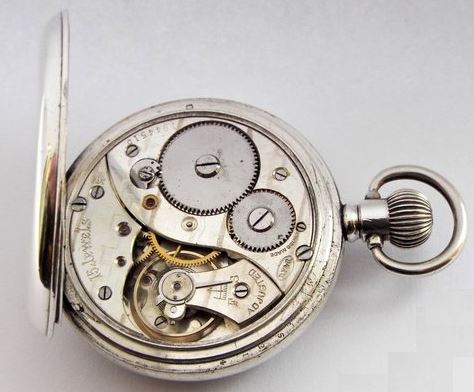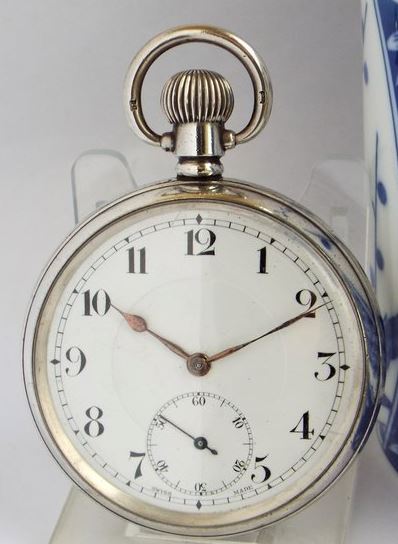Last updated on July 13, 2024
I am always looking for something different to add to my antique watch collection. Usually, I look for 15-jewel movements from noted manufacturers. In this instance, I found an antique pocket watch that comes from a noted importer of watches in the early 20th century, Dimier Freres & Co. There was no indication from my research that Dimier did anything more than fitting a completed Swiss movement to a locally sourced case. They were importers, not watchmakers. In this post, I will take a look at an antique high-grade Dimier Freres & Cie pocket watch, 1919.
Movement
The watch has a Swiss 15-jewel stem-winding movement which is ticking strongly as I type. In antique watches, 15-jewel movements are considered ‘fully jewelled’ and is an indication of quality. Although I have had some 7-jewel watches in my collection, I generally try and collect watches with a minimum of 15-jewels. The movement is protected by an inner hinged cover which has a few scratches from where it has been opened in the past. As a result, I would consider this to be patina rather than damage. These scratches are not visible during the day to day use and don’t detract from the piece at all. Overall, the watch movement is in very good clean condition.
The DF&C stamp on the movement is that of Dimier Freres et Cie. They were well-known importers and sellers of Swiss watches, with offices in La Chaux de Fonds, Switzerland and London. The DF&C mark was registered in 1901. They also worked under the brand names Selezi, Selex and Dimra. I viewed a lot of Dimier watches online while researching this post. Where the movement manufacturer was identified it, was always Revue Thommen.
Dimier Freres & Cie history
Dimier & Cie was founded by Jean Antoine Dimier (1795-1863) in Geneva in the early 19th century. Later records show that around 1835 the company had its premises at Rue Croix d’Or 27. Dimier specialised in pocket watches for the Chinese market. They were generally made of silver, brass, gilt brass or silver, and decorated with painted enamel with pearls or precious jewels. Enamel is a vitreous substance consisting mainly of silica mixed with metal oxides which creates a palette of colours. A metal base plate is coated with enamel and then fired. The colours were then applied in a powder form which the enamel painter dilutes using an oily essence, before applying them with a fine brush. Each colour is dried and fired before the next is applied. A piece of work can be fired numerous times.
Jean-Antoine Dimier had two sons, Charles-Louis (1822-1896) and Auguste-Antoine (1824-1891). The brothers graduated from the Collège de Genève and then followed in their father’s footsteps by embarking on a career in watchmaking. Charles moved to Canton around 1846 and established the company Dimier & Cie in China. Auguste remained in Switzerland and oversaw the production of the watches. Trading was discontinued in 1860, due to the civil war in China. As a result, Charles returned to Switzerland. In 1862 the two brothers set up a business in Geneva.
Importers
The loss of access to the Chinese markets may have forced the Dimier brothers to change their business model. They moved away from watch manufacturing completely and became an importer/exporter. Specifically, they exported Swiss made, Dimier branded watches and movements to England. In 1868 they opened a London office under the business name of Dimier Brothers & Company. Charles Dimier ran the London operations with premises at 46 Cannon Street. In 1918 the company was under the direction of George and Amelia Dimier. In the 1920s the company was renamed Georges Diemier SA with offices in La Chaux-de-Fonds, Geneva, Saint Sulpice, London and Croydon. The company finally closed in 1937.
Dimier Brothers played an important role at the beginning of the twentieth century in the introduction of the first modern wristwatches. In 1903 in England and Switzerland, they registered a design of curved fixed wire lugs to attach a leather strap to a wristwatch case. The Swiss-registered design was Déposé No. 9846. This meant that Swiss wristwatch manufacturers had to pay a fee to use the design. After the Assay of Imported Watch-Cases Act of 1907, which required Swiss made watch cases to be hallmarked in Britain, Dimier Brothers & Company began operating as assay agents from their London office.
Dimier Freres & Cie pocket watch case
Overall, the watch measures 50.6mm in diameter excluding the winding stem and the loop. The case is silver and has Birmingham hallmarks for 1919 with the case makers mark for the Dennison Watch Case Company. Overall, the case is in nice condition with just light surface marking from use and the odd mild mark to the back. Although it shows clear signs of use, all marks could be considered patina. The movement is protected by an inner hinged cover. In this instance, the complete Dimier branded movement would have been imported to England and fitted to the Dennison case, which was made in Birmingham.
The Dennison Watch Case Company
Aaron Lufkin Dennison (1812 – 1895) was an American-born businessman. He trained as a watchmaker and had a long career in the watchmaking industry. Dennison worked for several watchmaking companies, including one that was to eventually become the Waltham Watch Company. In 1864, Dennison founded the Tremont Watch Company in Boston. He intended to use imported components from Swiss manufacturers because labour costs were lower. Dennison left a business partner in charge in Boston and migrated to Switzerland to oversee operations. The Tremont Watch Company fell into financial difficulties in 1870. As a result, Dennison moved to England. In 1874, he founded the very successful Dennison Watch Case Company in Birmingham. Dennison supplied many watchmakers with cases made from a variety of materials.
The Dennison Watch Case Company began in a small workshop alongside the family home. Originally, the company was called Dennison, Wigley & Company and it grew to produce 100,000 high-quality watch cases per year. Dennison died in 1895 and the business was taken over by his son, Franklin Dennison. The company was renamed the Dennison Watch Case Company Ltd in 1905 and continued as a successful business until 1967.
Dimier Freres & Cie pocket watch dial
The watch has an acrylic lens, which is a replacement for the original glass crystal. Overall, it is in nice condition with only the odd minor mark from use. The double sunk dial is in near mint condition with no visible hairline cracks. The watch has rose gold coloured hands with a blued steel sub-seconds hand.
Dimier Freres & Co. silver pocket watch, 1919
The watch passed a 24-hour timekeeping test, running approximately one minute fast. This is perfectly acceptable accuracy for an antique watch. Overall, it is a practical and presentable watch, which I am pleased to include in my collection. Although, Dimier Freres & Co are not genuine watchmakers it has been very interesting investigating their history. However, I certainly couldn’t find a definitive history of Dimier Freres & Co. anywhere online. I was forced to make a few assumptions, such as the connection between Dimier & Cie and Dimier Freres & Co.
Related content
British Museum – Dimier Brothers & Co.


Looking at silver, red 12 trench watches circa WW1. Have seen one with imported silver mark & marked DF&Co in oval ring. It runs for up to 2 hours. Unsure if servicing will restore movement?
Tony
Hi Tony, the fact that it is running is a good sign, even if just for a few hours. A service will almost certainly get it running accurately. Typically, mechanical watches should be serviced every 5 – 10 years. The lubricant can and does dry out, plus mechanical watches can be affected by magnetism. Find a good watchmaker and get your watch serviced, you will then have a treasured and reliable timepiece. Thanks for commenting, Jason
I have in our family a DF & C pocket watch that belonged to my father in-laws father and was looking to find out some information if its worth anything,
it is sterling silver and when the rear case is open it is stamped FULL PATENT LEVER JEWELLED with two rear access areas for setting time and winding up with a key, there seems to be a serial number stamped 86916,
could you let me know on any details you would have about this pocket watch
Hi Derek, Dimier Freres & Cie were retailers, not watchmakers, they would have had this watch made for them and branded with the DF & C brand. The British hallmarks inside the case will be able to give you the date of the watch. In terms of value, there is the scrap value of the silver or the value as an antique timepiece. Neither value, is likely to be life changing, perhaps just a nice meal for two at a good restaurant. When determining value as a timepiece, you also need to consider if the watch has been recently serviced. I always say, that as a family heirloom, an antique watch will have more sentimental value than monetary. I hope you enjoy using your Dimier Freres & Cie pocket watch. Thanks for taking the time to comment, Jason